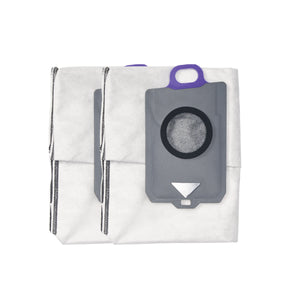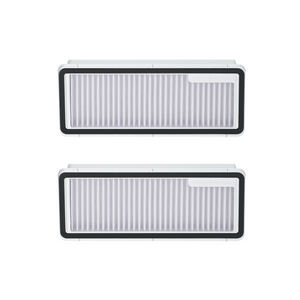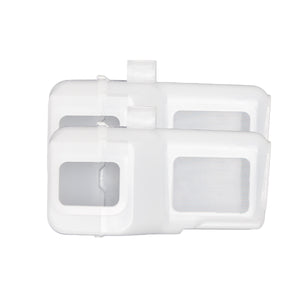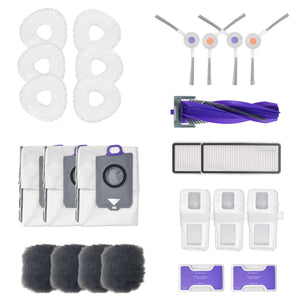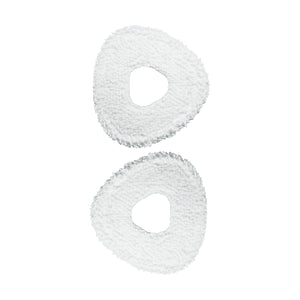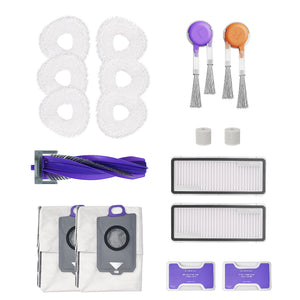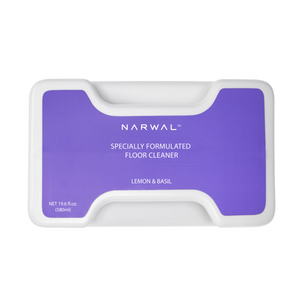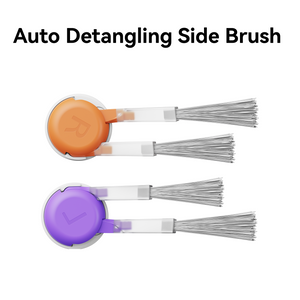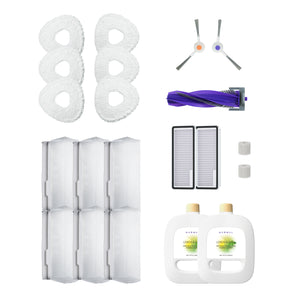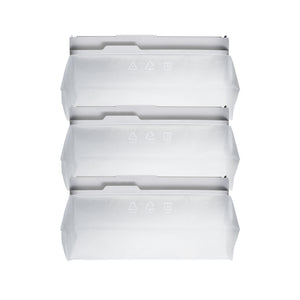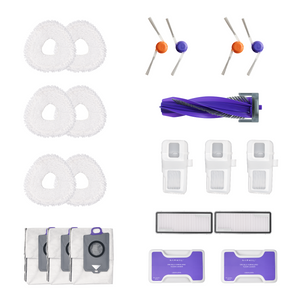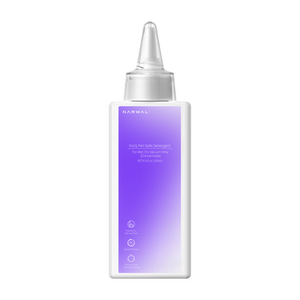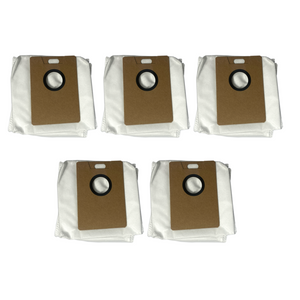Yes — if you’re tired of emptying the dustbin every other day, cleaning up after pets, or spending weekends chasing dust.
Self-emptying robot vacuums are built for busy homes. They don’t just vacuum — they automatically empty their dustbin, wash and dry the mop, manage water, and reduce your daily effort to nearly zero.
In this guide, we’ll break down why self-emptying robot vacuums with docking stations are worth it, which features actually matter, and the best models for different home types and cleaning needs.
Let’s dive in and help you choose the right hands-free system for your space.
What Is a Self-Emptying Docking Station, and How Does It Work?
A self-emptying docking station is a smart base that takes robot vacuum automation far beyond basic charging. It’s designed to handle the tedious task of emptying the vacuum’s internal dustbin — so you don’t have to.
Here’s how it works: After cleaning, the robot returns to the docking station. The station then uses powerful suction to transfer dust and debris from the robot into a larger, sealed bag inside the base. This bag can typically hold up to 30 to 60 days of debris, depending on your home's size and cleaning frequency.
The result is a cleaner experience with less manual work, less exposure to allergens, and far fewer interruptions in your cleaning routine.
On more advanced models, the docking station does even more — including mop washing, drying, water management, and self-cleaning — making it a truly hands-free floor care system.
What Can a Docking Station Do? Core Functions Explained
A docking station isn’t just a charging base — it’s the brain behind a fully automated floor cleaning routine. Here are the five key features that make it essential for hands-free operation:
-
Auto Dustbin Emptying: Automatically transfers debris from the robot’s dustbin into a larger sealed bag, reducing manual emptying to every 30–60 days.
-
Mop Washing and Drying: Cleans and dries mop pads after use, preventing dirt spread, bacteria growth, and foul odors.
-
Water Refill and Dirty Water Collection: Manages clean and used water separately, allowing for uninterrupted mopping without manual refills.
-
Self-Cleaning Mechanism: Rinses internal dock components to prevent buildup and maintain hygiene with less user intervention.
-
Smart Alerts and App Notifications: Keeps you updated on maintenance needs, dustbin status, or water levels — so you never miss a task.
Together, these features turn a robot vacuum into a truly hands-free cleaning system — ideal for those who want powerful results with minimal effort.
Pros and Cons of Self-Emptying Robot Vacuums With Docking Stations
Self-emptying robot vacuums with docking stations offer significant time-saving benefits and can dramatically reduce manual maintenance. However, they may not be ideal for every household. Understanding the trade-offs can help you decide if this technology is right for your space, lifestyle, and cleaning needs.
Advantages
-
Saves Time and Effort: No more emptying the dustbin after every cleaning session. The vacuum automatically deposits debris into a sealed bag in the dock, which typically lasts 30 to 60 days before needing replacement.
-
Improves Hygiene: Sealed dust bags reduce contact with dust and allergens, which can be especially beneficial for households with pets or allergy concerns.
-
Maintains Consistent Cleaning: By emptying itself automatically, the vacuum maintains suction and avoids cleaning interruptions due to full dustbins.
-
Reduces Manual Maintenance: Some models also wash and dry mop pads, refill water, and clean themselves — meaning fewer chores and cleaner results.
Weakness
-
Larger Dock Size: The docking station is bulkier than a standard charging base and may be difficult to place in small apartments or tight corners.
-
Potential Noise During Emptying: The suction process during self-emptying can be loud, particularly in quiet environments or at night.
-
Ongoing Consumables: Some models require disposable dust bags, which may lead to ongoing costs over time.
-
Brand Lock-In: Most docking stations only work with their own brand’s robot vacuums, limiting future upgrade flexibility.
Summary Table
|
Pros |
Cons |
|
Hands-free dustbin emptying |
Docking stations are often bulky |
|
Cleaner air and reduced allergens |
Self-emptying process can be noisy |
|
Continuous cleaning without pausing |
Requires compatible consumables (bags) |
|
Lower day-to-day maintenance |
Limited cross-brand compatibility |
How About Comparing Self-Emptying and Regular Robot Vacuums?

Self-emptying and regular robot vacuums differ in performance, convenience, hygiene, and allergen control.
Performance Comparison
When it comes to cleaning efficiency and effectiveness, both self-emptying and regular robot vacuums can perform well. However, self-emptying models have an edge due to their ability to maintain consistent suction power. Regular vacuums might lose efficiency as their dustbins fill up, requiring manual emptying to restore performance. User reviews and experiences often highlight the uninterrupted cleaning power of self-emptying vacuums, which ensures thorough cleaning even in larger homes.
Convenience Factor
In terms of daily usage and convenience, self-emptying robot vacuums offer significant advantages. They automate the tedious task of emptying the dustbin, which can be especially beneficial for those with busy schedules or physical limitations. The convenience of not having to frequently empty the dustbin translates to more free time and less hassle. Regular robot vacuums, while still convenient, require more hands-on maintenance, which can interrupt your routine.
Hygiene and Allergen Control
Self-emptying robot vacuums excel in hygiene and allergen control. They minimize exposure to dust and allergens by containing the emptying process within a larger, sealed bin. This feature is particularly beneficial for allergy sufferers, as it reduces the likelihood of particles being released back into the air. Regular robot vacuums, on the other hand, can expose users to dust and allergens each time the dustbin is emptied, which can negatively impact indoor air quality.
Cost vs. Benefit: Regular vs. Self-Emptying Robot Vacuums
|
Factor |
Regular Robot Vacuum |
Self-Emptying Robot Vacuum |
|
Initial Cost |
C$402 – C$804 |
C$938 – C$2,010 (Premium C$2,680+) |
|
Consumables |
Filters & brushes (low) |
Dust bags ~C$27–67/year + filters |
|
Maintenance Effort |
Frequent emptying (every run) |
Empty dock bin every 30–60 days |
|
Hygiene |
More dust exposure |
Sealed bag reduces allergens |
|
Time Saved |
Moderate |
High – “set & forget” |

What to Consider Before Choosing a Self-Emptying Robot Vacuum
Self-emptying robot vacuums can be a powerful time-saver — but whether they’re right for you depends on your daily routine, home layout, and cleaning needs. Here’s how to evaluate if they’re worth the investment.
Start with your cleaning frequency. If your floors need vacuuming daily — whether due to kids, pets, or allergies — the convenience of not emptying a dustbin every time can be significant. But if you only run the vacuum once a week, the difference may not justify the price.
Look at your living space. Do you have a spot for a larger docking station? Most self-emptying bases take up more space than standard chargers. In small apartments, this could be a challenge unless you choose a more compact model.
Think about your lifestyle. If you travel often, have limited mobility, or simply prefer low-maintenance solutions, self-emptying and self-cleaning features can reduce how often you need to interact with the device — sometimes to just a few times a year.
Don’t forget smart features. Many self-emptying vacuums rely on Wi-Fi for remote control, updates, or scheduling. If you value app integration and voice commands, these are useful. But if you prefer a manual setup, a simpler device may suit you better.
If you vacuum often, live with pets, value automation, and have the space — a self-emptying robot vacuum is likely worth it. If you clean occasionally, live in tight quarters, or want minimal setup — a regular robot vacuum may be enough.
Are There Any Recommended Self-Emptying Robot Vacuums?

Yes. Several top-rated self-emptying robot vacuums stand out in today’s market. Models like the iRobot Roomba s9+ and the Shark AI Ultra are often mentioned for their strong suction and reliable self-emptying bases. However, these options can be bulky, noisy, and come with recurring bag replacement costs.
Narwal takes a more advanced approach. The Freo Z Ultra offers a compact docking station, quieter operation at just 71dB, and built-in mop cleaning with electrolyzed water disinfection. This reduces maintenance and makes it ideal for households with pets or allergy concerns.
[cta:narwal-freo-z-ultra-robot-vacuum-mop]
For those who want the most cutting-edge option, the Narwal Flow is designed as a truly all-in-one solution. With FlowWash real-time mop self-cleaning, CarpetFocus deep carpet technology, 22,000Pa suction power, and a 120-day dust storage base, it redefines what “self-emptying” means. It’s quieter than most models (as low as 39dB), supports “Hey Nawa” voice control, and minimizes human intervention to just a few times per year.
[cta:flow-robot-vacuum-and-mop]
Self-Emptying Robot Vacuum Comparison
|
Model |
Key Features |
Pros |
Cons |
|
iRobot Roomba s9+ |
Strong suction, automatic dirt disposal |
Trusted brand, excellent carpet cleaning |
Bulky dock, noisy emptying, ongoing bag costs |
|
Shark AI Ultra |
Self-emptying base, AI laser navigation |
Affordable vs. competitors, solid performance |
Louder operation, more frequent maintenance |
|
Narwal Freo Z Ultra |
Compact base, mop washing with hot water & disinfection |
Quieter (71dB), low-maintenance, allergy-friendly |
Premium price, requires more space than non-self-emptying models |
|
Narwal Flow |
FlowWash real-time mop cleaning, CarpetFocus tech, 22,000Pa suction, 120-day dust storage |
Ultra-quiet (39dB), tangle-free, “Hey Nawa” voice control, minimal human intervention |
Higher upfront cost, advanced features may exceed casual needs |
If you want proven options, the Roomba s9+ and Shark AI Ultra remain reliable. But Narwal’s Freo Z Ultra and Flow take convenience further — solving noise, hygiene, and maintenance issues, and offering next-level automation.
FAQs
Are self-emptying robot vacuums worth the money?
Yes, self-emptying robot vacuums are worth the money for those who prioritize convenience and improved hygiene. They reduce the frequency of manual emptying, maintain consistent cleaning performance, and minimize exposure to dust and allergens, making them a valuable investment for many households.
Do I need a regular vacuum if I have a robot vacuum?
While robot vacuums are excellent for daily maintenance and keeping floors clean, having a regular vacuum is still useful for deep cleaning tasks, cleaning upholstery, stairs, and other areas that a robot vacuum might miss.
How many years do robot vacuums last?
Robot vacuums typically last between 3 to 5 years, depending on the brand, model, and how well they are maintained. Regular maintenance along with appropriate care can help extend the life of your robot vacuum.
Do robot vacuums know not to go downstairs?
Yes. Most modern robot vacuums are equipped with cliff or drop sensors that detect stairs and ledges. This prevents falls and protects the device from damage. However, it’s still recommended to monitor initial runs in multi-level homes.
Do self-emptying robot vacuums smell over time?
If not maintained, dust and pet hair stored in the docking station can create odors. Advanced models like the Narwal Freo Z Ultra and Narwal Flow include sterilization and deodorizing features that keep the base fresh and hygienic.
How long does it take to clean an average home?
Depending on layout and square footage, most robot vacuums take 60–120 minutes to finish a cleaning cycle. Self-emptying models maintain consistent suction, so they can handle longer sessions without interruption.
Upgrade Your Cleaning Routine with Narwal
Self-emptying robot vacuums are more than a luxury — they free you from daily dustbin emptying, reduce exposure to allergens, and keep cleaning consistent. For busy families, pet owners, and anyone who values a healthier home, this convenience makes a real difference.
With the Narwal Freo Z Ultra and the all-new Narwal Flow, you’ll experience next-level automation: compact docking stations, whisper-quiet self-emptying, and advanced self-cleaning that means you only step in a few times per year.
Choose Narwal and enjoy a smarter, truly hands-free way to keep your home spotless.



















